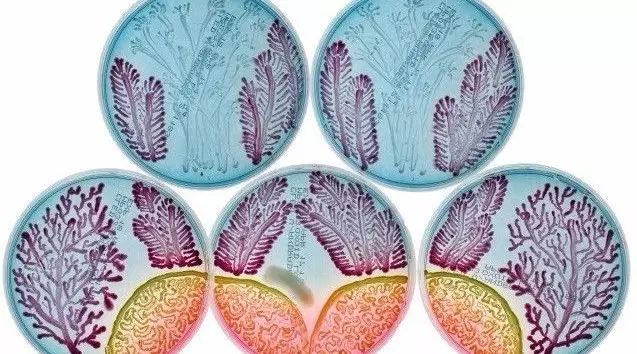
There is a strong indiscriminate entry of cold jokes this year.
petri dish art, reserved entertainment programs in the microbiology lab. This year, the American Society of Microbiology held a new petri dish art competition, which is the third year this year. Today, let's take a look at this year's award-winning work
the first winner was inspired by the sunset seen in Montauk in the summer. This painting is drawn in a special way. Instead of using a traditional inoculation ring to underline a petri dish, it uses a similar printing method to inoculate a lot of different yeasts "pixel" on a large plate. These yeasts contain plasmids that encode different pigments.
author: Jasmine Temple, Laboratory Technician
Jef Boeke, PhD, Director, Institute for Systems Genetics
Michael Shen, Graduate Student
Leslie Mitchell, PhD, Postdoctoral Fellow, New York University, New York, United States
the second work was inspired by the animated movie finding Nemo (Finding nemo). The author painted a picture of coral with several different colors of bacteria and fungi. Here, the purple part is Serratia marcescens, the pink part with a little yellow and green is Staphylococcus aureus (Staphylococcus aureus), the white part is tropical Candida albicans (Candida tropicalis), and the gray slimy part (I understand is that unknown object in the middle? ) is Klebsiella pneumoniae.
and the coldest thing is that the name of this painting is "Finding Pneumo" (looking for pneumonia, named after Klebsiella pneumoniae, which is synonymous with the original name), who is looking for it? However, the creators said seriously that they hope to draw attention to corals, which are not living very well in the context of global warming.
author: Linh Ngo, Microbiology Technologist, Sunnybrook Health Science Centre, Ontario, Canada
then comes a rather exquisite work called "Dancing Microbes". The white color of a girl's dress comes from Staphylococcus epidermidis (Staphylococcus epidermidis), a bacterium that can be found on the surface of our skin and can coexist peacefully with humans. The tones of pink and red come from Rhodotorula mucilaginosa, which is common in soil. Micrococcus luteus (Micrococcus luteus) provides yellow, while Xanthomonas campestris (Xanthomonas axonopodis) provides green, which is the pathogen that can infect plants. In any case, they still dance in harmony on this petri dish.
author: Ana Tsitsishvili, Undergraduate Student, Agricultural University of Georgia, Tbilisi, Georgia
finally, I would like to introduce the popular Choice Award, which is most loved by onlookers. The painting skills of this work can indeed be said to be very excellent. This is a portrait on a petri dish! It is the look of the laboratory founder of graduate student painting in HiMedia Lab in India.
although only one kind of bacteria is used, it is very good. But students, choose to use Enterococcus faecalis to paint is to reflect what kind of inner activities ah.
author: Yogita Pankaj Phalke, MSc Girish Mahajan, PhD, FSAB, HiMedia Laboratories, Mumbai, India
Isn't it marvellous and exhilarating to find a stunning fairytale prom dress for your event? We have cuts and forms to fit any silhouette.
which one do you like? After reading it, I feel that Finding Pneumo won
Source: https://www.asm.org/index.php/public-outreach/agar-art